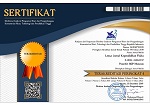Development of Basic Physics Experiment Textbooks Based on Pictorial Riddles
Abstract
Keywords
Full Text:
PDFReferences
Azhar, A. (2011). Media Pembelajaran. Jakarta: PT. Raja Grafindo Persada.
Depino, P. (2011). Yale-New Haven Teachers Institute: A Creative Classroom Model for a Sixth Grade Science Class.
Elliot, S., N. (2000). Educational Psycology: Effective teaching, Effective learning. 3 rd Ed. Boston: McGraw – Hill
Fatkhurrohman, M.A & Astuti, R.K. (2017). Pengembangan Modul Fisika Dasar I Berbasis Literasi Sains. Jurnal Pancasakti Science Education Journal PSEJ. 2(2):63-171.
Hamruni. (2009). Strategi dan Model- Model Pembelajaran Aktif Menyenangkan. Yogyakarta: Fakultas Tarbiyah UIN Sunan Kalijaga.
Junaidi, S.N. & Asra, A. (2019). Pengembangan Buku Ajar Fisika Dasar Berbasis Pictorial Riddle Untuk Mahasiswa Pendidikan Biologi. Diffraction: Journal for Physics Education and Apllied Physics. Vol.1 No.2: 2685-7723.
Permana, F.H. (2015). Pengembangan Buku Ajar Biologi Berbasis Blended Learning Sebagai Bekal Hidup Di Abad 21 Untuk Mahasiswa S1 Kimia FMIPA UM. Prosiding Seminar Nasional Pendidikan Biologi 2015. Malang: Universitas Muhammadiyah Malang.
Plomp, T. (2013). Educational and Training System Design. Enschede. Netherlands: Univercity of Twente.
Prastowo, A. (2011). Panduan Kreatif Membuat Bahan Ajar Inovatif. Yogjakarata: Diva press
Rachmawati W.S. (2004). Anatomi Buku Ajar. Departemen Pendidikan Nasional. Jakarta.
Riduwan. (2009). Belajar Mudah Penelitian untuk Guru, Karyawan, dan Peneliti Pemula. Bandung: Alfabeta.
R. Maulida and M. P. Simanjutak. (2015). Pengembangan Bahan Ajar Fisika SMA Berbasis Investigasi pada Materi Fluida Dinamis Untuk Meningkatkan Hasil Belajar Siswa, Jurnal Pendidikan Fisika, 4(1), 71-76.
Sugiyono. (2012). Metode Penelitian Pendidikan. Bandung: Alfabeta.
Sukmadinata & Nana Syaodih. (2012). Metode Penelitian Pendidikan. Bandung: Remaja Rosdakarya.
Viera, A.J & Garret, J.M. (2005). Understanding Interobserver Agreement the Kappa Statistic. Research. Journal Research Series Vol.37 No.5
DOI: https://doi.org/10.33394/j-lkf.v9i1.3857
Refbacks
- There are currently no refbacks.

This work is licensed under a Creative Commons Attribution-ShareAlike 4.0 International License.

Lensa: Jurnal Kependidikan Fisika is licensed under a Creative Commons Attribution-ShareAlike 4.0 International License.


.png)